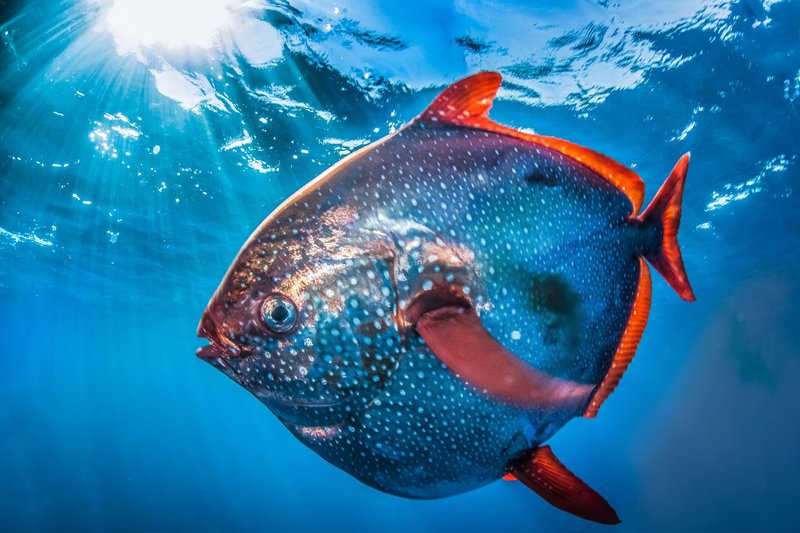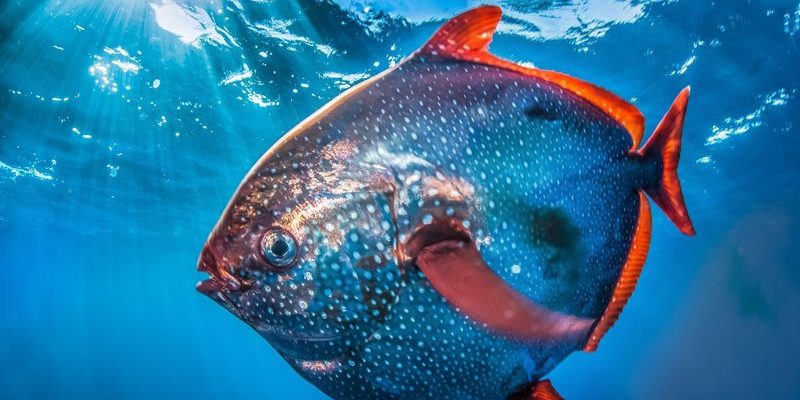
The Opah, also known as the moonfish, is a mesmerizing creature that swims through the depths of our oceans. Think of it as a vibrant burst of color amidst the blues and greens of aquatic life. With its round body and striking hues, the Opah stands out in any environment. It’s not just its appearance that makes it fascinating, though; this fish has some unique features that truly set it apart from other species.
Imagine a fish that can regulate its own body temperature! That’s right; the Opah has a special ability that allows it to stay warm even in chilly waters. This trait is rare among fish and enables the Opah to be an efficient predator, hunting its favorite meals with speed and agility. The combination of its beautiful appearance and exceptional skills creates a captivating aquatic marvel.
Physical Characteristics
One of the first things you notice about the Opah is its striking coloration. It displays vibrant reds and blues that shimmer under sunlight, creating a spectacular visual. Their bodies are somewhat circular, making them look almost like a giant coin swimming through water. These colors serve a purpose too: they help in communication with other fish and camouflage them against the ocean backdrop.
In terms of size, Opahs can grow quite large, typically reaching about 3 feet long, though some individuals can grow even bigger. Their bodies are thick and meaty, with a large dorsal fin that runs along the top. This fin helps them steer through the water with grace. Another notable feature is their large, round eyes, which give them excellent vision underwater—perfect for spotting prey in dim lighting.
Moreover, their unique gills allow them to extract oxygen from the water effectively, which is vital for their active lifestyle. All these characteristics combine to make the Opah not only visually stunning but also well-adapted to its environment.
Habitat and Distribution
Opahs are found in many of the world’s oceans, particularly in tropical and temperate waters. They tend to enjoy deeper oceanic regions, often swimming at depths of around 600 feet but sometimes venturing closer to the surface. You can think of them as the explorers of the ocean, thriving in both warm and cooler waters.
These fish prefer areas with plenty of food, such as squid, small fish, and crustaceans, which they hunt with precision. Their adaptability to different oceanic conditions contributes to their broad distribution, which spans from the Mediterranean Sea to the coasts of North America and Australia. This versatility also means they can thrive in a variety of environments, making them a staple of oceanic biodiversity.
During their lifespan, which can exceed 11 years, Opahs may migrate between different regions in search of food or suitable breeding grounds. Their movement patterns highlight the importance of understanding their habitat to protect these magnificent creatures.
Diet and Feeding Habits
Opahs are carnivorous and have quite the appetite! Their diet mainly consists of small fish, squid, and crustaceans. Imagine being a fish that can afford to be picky about its meals due to its efficient hunting skills. They use their excellent vision and swift movements to catch prey, often ambushing them in quick bursts of speed.
What’s interesting is that Opahs have a unique method of hunting. They actively chase down their food rather than just waiting for it to come to them. This method leads to an energetic lifestyle, which is crucial for a fish that can warm its body. Being warm-blooded means they have a higher metabolic rate, allowing them to hunt more effectively compared to other fish.
In terms of feeding strategy, Opahs are known to hunt either alone or in small groups. This social aspect of their behavior can help them tackle larger prey and enhance their hunting successes. Just picture them working together to snag a meal, showcasing both their intelligence and teamwork.
A Unique Adaptation: Warm-Blooded Fish
You might be surprised to learn that the Opah is the only known fully warm-blooded fish. While most fish are cold-blooded, relying on the temperature of their surroundings, the Opah has adapted to maintain a warmer body temperature. This trait is particularly useful in colder waters, giving them a competitive edge while hunting for food.
The Opah achieves this through a unique circulatory system, where its gills and blood vessels work together to trap and retain heat. This adaptation allows them to be more active and agile than their cold-blooded counterparts, which can be sluggish in chilly waters. Imagine being able to swim faster and hunt with greater efficiency simply because your body is warm!
This incredible ability also expands their hunting grounds, allowing them to pursue prey that other fish might struggle to catch. It’s a fascinating example of how evolution shapes animals to thrive in their environments, making the Opah a remarkable study in adaptability and survival.
Reproduction and Lifespan
Opahs reach sexual maturity after about two years, and the details of their reproductive habits are still a bit of a mystery. They are thought to spawn in warm ocean waters, where the females release eggs that drift freely through the water. These eggs will hatch into larvae that will eventually develop into juvenile Opahs, continuing the cycle of life.
Life as a young Opah can be challenging. They must navigate through a world filled with potential predators, learning quickly how to fend for themselves. Once they mature, they can live for more than 11 years, making them a long-lived species in the fish world. Isn’t it fascinating to think about the journey of an Opah from a tiny egg to a large, vibrant fish?
Conservation efforts are essential to protect these remarkable creatures and their breeding habitats. By understanding their life cycle, we can contribute to their preservation and ensure future generations get to marvel at these colorful fish.
Threats and Conservation Status
Like many marine species, Opahs face several threats that could impact their populations. Overfishing and habitat degradation are significant concerns. Fishing practices that deplete their prey or destroy their nesting grounds can have lasting effects on the Opah population. Additionally, climate change poses a risk to their habitats, as rising ocean temperatures can disrupt the delicate balance of the marine ecosystem.
Despite these challenges, the Opah is currently not considered endangered. However, keeping a close eye on their numbers is crucial. Conservation efforts focus on sustainable fishing practices and protecting their habitats to ensure that these beautiful fish continue to thrive in our oceans.
Supporting organizations that promote marine conservation can help raise awareness and protect Opah populations. Each small action counts in preserving the diversity of our oceans, so consider getting involved in local conservation efforts!
Interesting Facts About Opah
- The Opah is the only warm-blooded fish.
- It can grow up to 3 feet long and weigh over 200 pounds.
- Opahs have a large dorsal fin that helps them navigate through water.
- They can live for over 11 years in the wild.
- Their vibrant colors can change depending on their mood and environment.
| Fact | Details |
| Size | Up to 3 feet long |
| Weight | Over 200 pounds |
| Habitat | Tropical and temperate waters |
| Diet | Small fish, squid, crustaceans |
| Lifespan | Can exceed 11 years |
FAQ
What does an Opah look like?
The Opah is a remarkable fish known for its vibrant colors. It features a round, thick body with a combination of red, blue, and silver hues that shimmer in the water. Its large round eyes and prominent dorsal fin add to its striking appearance, making it one of the most visually stunning fish in the ocean.
Where can I find Opahs?
You can find Opahs in tropical and temperate oceans around the world. They thrive in deeper waters, typically at depths of around 600 feet. Regions such as the Mediterranean Sea, North America, and off the coast of Australia are known habitats for this beautiful fish.
How do Opahs hunt their prey?
Opahs are active hunters and prefer to chase down their prey rather than wait for it to come to them. Their excellent vision and swift movements allow them to ambush small fish, squid, and crustaceans effectively. Their warm-blooded nature also gives them a speed advantage over many cold-blooded fish.
Are Opahs endangered?
While Opahs are not currently classified as endangered, they do face threats from overfishing and habitat degradation. Conservation efforts are essential to ensure their population remains stable. Supporting sustainable fishing practices can help protect these magnificent creatures.
How long do Opahs live?
An Opah can live for over 11 years in the wild, making them relatively long-lived compared to many other fish species. Their lifespan can be influenced by environmental conditions and predation risks.
What do Opahs eat?
Opahs are carnivorous and primarily feed on small fish, squid, and crustaceans. They are opportunistic hunters, using their speed and agility to catch their favorite meals. Their diet largely depends on the availability of prey in their habitat.
Why is the Opah considered unique?
The Opah is unique because it is the only fully warm-blooded fish. This exceptional adaptation allows it to be more active in colder waters, making it a more efficient predator. Its vibrant colors and large size also contribute to its uniqueness in the aquatic world.
How do Opahs reproduce?
Opahs are believed to spawn in warm ocean waters, releasing eggs that drift freely. The young Opah larvae must navigate a challenging environment filled with predators until they mature. The specifics of their reproductive behavior are still being studied by scientists.
Can Opahs change color?
Yes, Opahs can change color depending on their mood and environment. This ability helps them communicate with other fish and can also aid in camouflage against predators. Their color-changing capability is just one aspect of what makes them fascinating!
How do Opahs adapt to their environment?
Opahs have a remarkable ability to adapt to various ocean conditions. Their warm-blooded nature allows them to thrive in both warm and cooler waters, giving them access to a broader range of habitats and food sources. This adaptability is crucial for their survival in changing environments.

